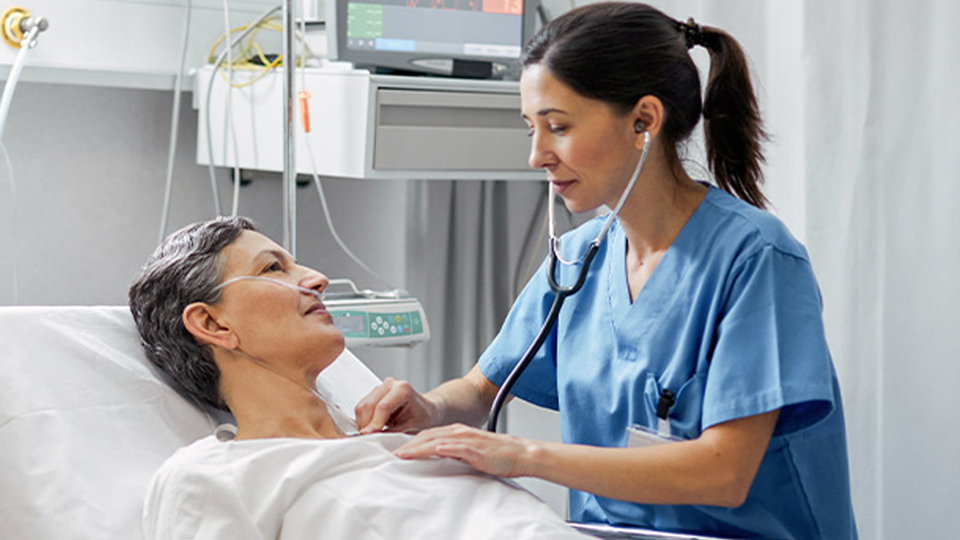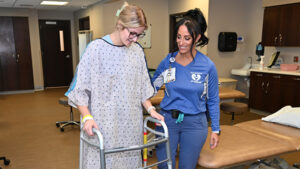Inpatient Medical Rehab Unit (MRU)
How to get a referral to ECMC’s Medical Rehab Unit
- Tell your doctor about your interest in ECMC’s rehabilitation program.
- A rehabilitation admissions director and physiatrist will be called to evaluate your rehabilitation needs. They will then make a recommendation about which level of rehab is best for your recovery and discuss admission requirements and insurance participation.
- Once accepted, you may be transferred to our Medical Rehab Unit to begin your recovery so you can return home in the best physical condition possible.
Referral Information for Your Doctor/Discharge Planning Team:
- ECMC – MEDICAL REHAB UNIT (MRU)
Head Trauma and Stroke Recovery Rehabilitation
Our head trauma and stroke rehabilitation programs utilize an interdisciplinary approach to help patients recover to their fullest potential. Patients will begin learning how to take care of themselves again. Dependent on the level of recovery needed, goals will include learning to wash, dress, and feed themselves, and improving their ability to swallow food. Patients will also work on getting themselves out of bed and progressing towards the development of appropriate mobility skills based on their recovery circumstances. Family members or caregivers will have opportunities to participate in care to prepare the patient to return home.
ECMC MRU Performance
ECMC treats patients with injuries and illnesses that are the most challenging in the nation. And using a standardized measures known as the Functional Independence Measure (FIM), ECMC’s Acute Medical Rehabilitation Unit has outperformed 916 national and 59 regional facilities with above average independence achieved by discharge. Refer to the chart for specific diagnostic details (Source: UDSMR 2021). Some of our best outcomes were achieved with people who had suffered traumatic and non-traumatic brain injuries, burns, paralysis from traumatic spinal cord injuries, as well as patients who experienced neurologic conditions.
What does this mean? It means that when patients were discharged from our Medical Rehab Unit, they were able to handle more of their own care with better mobility and less assistance than those who received care from our competitors.
Demographics
Based on data from 2021, ECMC MRU patient demographics reflect that the most common patient age group was between 45 and 64 years old, 70.4% were male, 46.3% were single, 7% divorced, or separated, yet 66.6% were discharged home with the assistance of family members. Ethnicity breakout was 66.5% Caucasian, 23.2% African American, 3.4% Hispanic, 4.9% Asian, and 2% Native American. The top five primary payers included No Fault Auto Insurance 24.1%, Medicare 13.8%, Medicare Advantage 19.2%, Medicaid Managed Care 13.8%, and Commercial Insurance 18.2%.
Additional Info
LOCATION
Center for Rehabilitation Services
ECMC Main Building
462 Grider Street
Buffalo, NY 14215
HOURS OF OPERATION
General Visiting Hours
Monday – Sunday
10:00 a.m.-9:00 p.m.
CONTACT
Admissions
(716) 898-6594 or (716) 898-6167
Fax
(716) 898-4625
Frequently Asked Questions
Why ECMC Rehab?
The Medical Rehabilitation Unit (MRU) at ECMC, founded in 1978, has a long history of dedication to the community, helping sick and injured people return to their families, homes, and careers. Our MRU accepts the most challenging patients in the nation (Highest Case Mix Index*) and provides the care and rehabilitation needed for the most optimal outcomes possible. Our therapists have extensive expertise treating serious injuries, such as those to the spinal cord, brain, and those involving multiple traumas. While a subacute rehab unit is appropriate for less involved cases, our Acute Medical Rehabilitation Unit gives patients more time with the therapists, more time with the physiatrist (rehab doctor), and a higher percentage of discharges to home.
Why is the Commission on Accreditation of Rehabilitation Facilities (CARF) important?
ECMC has been awarded a CARF three-year accreditation for its Inpatient Physical Rehabilitation Program. ECMC was recognized with this great honor for Excellence in Rehabilitation. ECMC is also one of the nation’s and region’s top performers for improved independence after sustaining a brain injury, pulmonary, orthopedic or burn injury.
Accreditation is the result of a rigorous peer-review process in which ECMC demonstrated to a team of surveyors, during an on-site visit, that its rehabilitation services are of the highest quality.
CARF is an independent, internationally recognized accrediting body whose mission is to promote the quality, value, and optimal outcomes of services through a consultative accreditation process.
How are acute medical rehabilitation and sub-acute rehabilitation different?
Acute medical rehabilitation is appropriate for patients who will benefit from an intensive, interdisciplinary rehabilitation program. Patients receive occupational therapy, physical therapy, and speech therapy as needed for three hours daily. Patients are medically managed daily by specially trained physicians and nurse practitioners. In contrast, subacute rehabilitation is less intensive. Subacute rehabilitation units are housed in skilled nursing facilities where patients receive one or two hours of therapy daily. Subacute patients are seen by their attending physicians on a monthly basis.
How can ECMC rehabilitation help me?
All your needs can be met under one roof at ECMC, from acute medical rehabilitation to outpatient rehabilitation. When you choose to stay at ECMC for your acute medical rehab needs, you can rely on continuity of care as your physician will remain in contact with you and the rehab team treating you. When it is time for you to return home, our team will set up any home care services or equipment you need to ensure the transition is a smooth one.
Additional Rehab Services
Outpatient Therapy Services
The outpatient rehabilitation program is an interdisciplinary team of skilled staff that provide patient centered evaluations and consults for patients with any injury or illness effecting functional performance and quality of life.
Rehabilitation Psychology Services
Our rehabilitation program emphasizes a holistic approach to emotional health and recovery by providing effective management of injuries and illnesses.
Pediatric Education & Diagnostic Services (PEDS)
ECMC provides community-based multidisciplinary evaluations and therapeutic services to children, from birth to five years of age, through NYS Early Intervention Program or the Committee on Preschool Special Education in the child’s school district.


